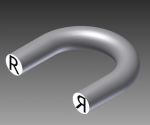
Acrolite Sensor Assemblies
Fiber Optic Sensors use the ability to move light to, past or around an object, through a system of glass fibers, and return a signal to a measuring device. Fiber Optic Sensors are available in two distinct types; Intrinsic or Extrinsic.
Intrinsic Sensor:
An Intrinsic Sensor uses the changes in the optical properties of the fiber itself as the means of detection. Monitor strain by observing changes in the fibers optical parameters.
Extrinsic Sensor:
In an Extrinsic Sensor, the fiber acts as a delivery system for a source of energy to a modulating medium, and returns the modulated signal back to a detector.
A through beam pair; simply blocking a beam of light can be used. For part detection or to tell a store owner that you have arrived.
Retro-Reflector; substitute a reflector at one end of the beam and you have another way to detect parts or people.
Color Detection; supply white light to a surface and by using a spectrum analyzer or discrete filters, determine the color of the sample. With proper design and testing other surface properties such as roughness, gloss and reflectance can be determined.
Application:
By the introduction of properly selected modulating materials, the Range of parameters which can be monitored or measured with Fiber Optic Sensors include but are not limited to; pressure, temperature, color, surface condition, blood chemistry, strain, Ph, turbidity, flow, fluid level, magnetic fields, and many, many others.
The ability to move light to, past or around an object through a fiber and return a signal to a measurement system allows sensors to reach areas that in the past has been too difficult to reach due to access, temperature, electric interference or other factors. The immunity of fiber to electro-magnetic interference makes it an excellent choice for areas where there are strong electric, magnetic fields or just a very noisy electrical environment.
The small size of optical fibers also allows the ability to access very small areas; a continuous complete chemical lab can be built on the tip of a fiber to allow continuous real time monitoring of blood chemistry within the human body.
The ability of Fiber Optic Sensors to meet the expanding requirements of the sensor industry is limited only by the needs and imagination of designer and engineers working in the field.
Sensor Assemblies Solutions Gallery
Capabilities
Combine electrical and optical conductors in a single assembly to provide both lighting and data.
Can work to IPC/WHMA-A-620 with wire as small as 28 gauge and bundles as small as .008” in multi-pin connectors which include the optical connections as well.
Tight tolerances and small diameter bundles are our specialty.
If you have been told by other suppliers your design is too difficult or impractical, you should contact Acrolite for solutions to your needs.
Acrolite Solutions
CHALLENGE: Customer required means to detect flaws in the manufacturing of tubing.
ACROLITE SOLUTION:
Acrolite developed a system which included illumination and detection of variations in the product.
CHALLENGE: Customer required a component which could provide illumination, calibration and detection of several different blood chemistries in a single, compact unit.
ACROLITE SOLUTION:
Acrolite developed an optical component which is capable of all the required functions.




